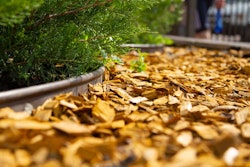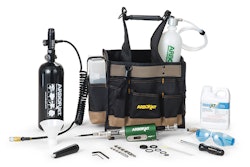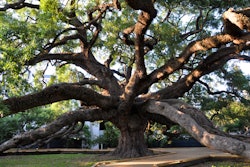Compared with the rest of the landscape, trees are about as low-maintenance as you can get, which makes them easy to overlook. Sure, you remember to water and fertilize them with the rest of the lawn, but they really need more than that to thrive. A regular maintenance program will add vigor and help prevent future problems – and you’ll still spend less time on it than the rest of the landscape, guaranteed.
1. At least once a season, perform an overall evaluation of each tree’s health. Start by noting any dead or damaged branches and follow up to ensure there isn’t a pattern indicating a more serious problem. Remove the damaged branches as quickly as possible. You want them off the tree because they are especially susceptible to insects and disease.
Also look at the growth pattern of the tree. You can examine a branch to determine yearly growth. Just find the new buds and then look for the scars from last year’s buds. The amount of growth will vary by tree, so you’ll need to compare it to what is normal for that specific type of tree. But you can also compare this year’s growth to that over the past three years by evaluating the scars from previous years’ buds. With the exception of a few slow years after planting, the growth pattern should be about the same each year.
Check leaves. They should be an appropriate color for the season and also have similar shape. If the leaves are oddly shaped, it could be an indication that there is a more serious problem with the tree. The leaves should not be wilted. Wilted leaves can be a sign of something as simple as needing more water or as serious as disease.
The last – and most critical – element of the evaluation is to check for obvious signs of insects or disease. Look for holes in the bark and insects.
2. Plan for pruning, but not topping. The International Society for Arboriculture (ISA) is resolute in its warning against topping trees. Topping is a method used for reducing the size of a tree, sometimes by as much as 50 percent to 80 percent of the crown, by cutting branches back to stubs. These stubs never heal and provide easy access to pests. Because the leaves are the food factory of the tree, removing them to this degree can starve the tree, sending it into survival mode. The result: The tree will be more susceptible to disease and more attractive to insects in its weakened state. It also weakens the subsequent replacement branches.
Proper pruning removes excessive growth without the negative side effects of topping. Never remove more than one-quarter of a tree’s crown in a season. All pruning should be done to improve tree structure, enhance vigor or maintain safety. The ISA instructs that no branch should ever be removed without a reason.
3. Fertilize. If trees are healthy, planted in a place where they have ideal soil conditions, plenty of water and sunshine, they will thrive. But many residential and commercial landscapes are less than ideal, so trees are typically going to require additional nutrients.
It’s important to note that typical weed-and-feed fertilizer you may be using on the lawn may not be doing any favors for the trees. According to the ISA, soil conditions, especially pH and organic matter content, vary greatly, making the proper selection and use of fertilizer a somewhat complex process. “When dealing with a mature tree that provides considerable benefits and value to your landscape, it is worth the time and investment to have the soil tested for nutrient content.”









